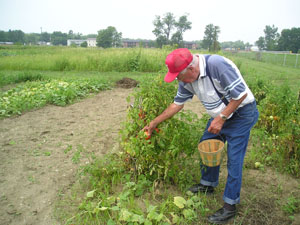By Janie Southard
jsouthard@dailystandard.com ST. MARYS -- During the past 30 years or so, Pal Halbert figures he has probably planted about 900 tomato plants in the Goodyear garden plots in St. Marys.

"Goodyear turns over the ground in the spring, cuts the grass path around the plots all summer and provides the water. It's a pretty good deal," Halbert says as he plucks big, red beefsteaks from a plant just loaded with fruit.
Sometimes he eats a couple tomatoes right off the vine while they're still warm from the sunshine.
Although it's not been a bumper year for tomatoes, Halbert says he is happy with his crop.
"I've had all I want, and I've given so many to friends they're now telling me they've got enough," he says. He starts right away in the spring working the ground with a little rototiller that "really does the job" until he's got that soft spongy dirt that plants seem to love. In addition to 30 tomato plants, his crop this year includes cucumbers, several varieties of peppers, cabbage, big onions and zucchini.
"Don't forget beets. I had some real pretty beets this year. Just pulled them up last week, and my wife canned some. She used to can a lot of stuff, but this year it was only beets," he says as he begins filling another basket with tomatoes.
Halbert, who retired in 1990 after 25 years at Goodyear Tire & Rubber Company in St. Marys, is originally from Kentucky and did a short stint at Mersman Furniture Co. in Celina.
"I had to rub down tables, and I just got sick of it. Finally they put me in milling. That was better, but I left anyway and went to Goodyear," he says.
Several Goodyear retirees recall the company began the garden plot project in the early- to mid-1940s and many believe it was part of the Victory Garden movement.
"Plant a Victory Garden: Help Win the War!" was a common slogan during World War II. "Dig to Win" was another.
There was a lot more than vegetables behind those original Victory Gardens. They represented a hands-on opportunity for the folks waiting at home to help the war effort as well as themselves stretch their rations a little further.
This movement of "city farmers" produced countless gardens in backyards and empty lots, as well as plots sponsored by corporations such as Goodyear.
Laura Anderson of St. Marys believes the Goodyear plots were Victory Gardens to start with, although her gardening there was in the mid-1960s.
Anderson, whose former husband Ron was a Goodyear employee, recalls that the original gardens were behind Goodyear, rather than to the east of the company along state Route 66 where the 46 garden plots are now. She says it was Mel Hamp who did the original plowing to get the plots ready.
"One year, in the early 1960s, I had nine rows each 35 feet long of all kinds of beans -- green, wax, limas -- plus a lot of other vegetables. My friend Esther Carpenter and I canned and froze garden produce all summer long.
"She had an old-fashioned plow like you'd hitch up a horse to, but Esther and I hitched up ourselves and worked the ground that way," says Anderson, who now works at Agape in St. Marys.
The next year she pooled her birthday money and bought a little tiller, which saved the two women a lot of backaches.
For several years, the garden program was shut down and was restored in the early 1990s by the late Pat Miller, then a buyer for the company, according to Steve Tenyak, a department manager at the St. Marys plant. The garden plots are now known as the Pat Miller Memorial Gardens.
"I remember my dad had a plot out there in the early 1950s. Did I help with his garden? Oh no, I was way too lazy in those days to get out and work," Tenyak confesses.
|

